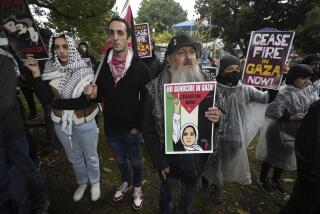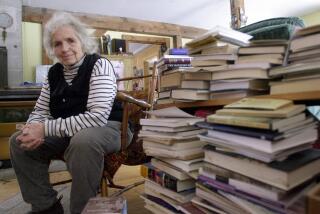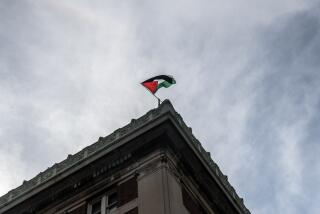Hardship before horror
“I don’t want to die!” -- in handwritten Yiddish, the words on the frontispiece of this remarkable book. To the left, their author, a man probably in his early 20s, dark-haired, looks wistfully at the camera, and below the photograph, also in Yiddish, the inscription “My Skeletal Autobiography for the YIVO Competition” (mayn skeletishe oytobiografye farn konkurs fun yivo).
We don’t know the young man’s name, but we soon learn who he is: one of several hundred Jewish young men and women, between the ages of 16 and 24, who submitted their autobiographies (averaging 7,000 words each) to that fortress of Yiddish language and culture, the Yiddish Scientific Institute in Vilna, in response to competitions it announced in 1932, 1934 and 1938. The purpose of the autobiographies was twofold: First, to provide the YIVO (the institute’s Yiddish acronym) with a greater understanding of the problems facing Jewish youth at that time, and second, to get young people to become more committed to the preservation of Yiddish culture at a time when assimilation posed a threat to its survival.
The architect of the project was the institute’s head, Max Weinreich, a brilliant literary scholar, linguist and historian. About 1,000 essays came in, and one can only speculate how many more could have been written had it not been for the decimation of a culture and a people, including the authors of most of these autobiographies.
The Vilna ghetto was established in September 1941, less than two months after the Germans captured the city in their eastward march, but even before the establishment of the ghetto, the Jews were exposed to barbaric treatment. About 40,000 Jews were executed in the tiny village of Ponar near Vilna in 1942 and the remaining 40,000 were all crammed into a tiny space encompassing seven narrow streets. Less than two years later, the last Nazi Aktion, or military raid, left about 15,000 Jews still alive. In 1944, the Vilna ghetto was no more, its last inhabitants all deported to death camps in Estonia.
About half of the autobiographies went up in flames together with the Vilna ghetto in that 1944 Aktion. Of the 300 or so that survived, editor Jeffrey Shandler has selected 15 for this volume, and there is no doubt these autobiographies will serve as a source for understanding a whole interwar generation of Polish Jews.
Indeed, “Awakening Lives,” with its valuable and trenchant introduction by Barbara Kirshenblatt- Gimblett, Marcus Moseley and Michael Stanislawski, should be obligatory reading for the many, here and in Europe, who concentrate on the period of death and destruction of European Jewry and tend to ignore the life that preceded it. (Think of the numerous Holocaust studies, Holocaust museums or the young men and women -- I have met quite a few of them -- who are intrigued by the feminist aspects of daily life in German concentration camps or how to arrange photographs of Nazi atrocities so as to create the maximum impact on the viewer, yet remain astonishingly uninformed about Yiddish or Hebrew literature of the 20th century, or the influence of the Enlightenment on Jewish institutions in the 18th and 19th centuries -- all rather like reading Martin Luther without ever having read the Gospels.)
“Awakening Lives” reveals a great deal about that prewar life, not only through the facts it conveys but also by the charming, candid and sometimes self-lacerating tone of the essays. The organizers of the competitions were not looking for “literary talent”; they did not want the writers to strive for “beautiful language.” They wanted simplicity, sincerity and attention to detail from the entrants, who wrote in Polish, Hebrew, Russian or, for the vast majority, Yiddish.
Though the impassioned cry of “I don’t want to die!” could be taken as a cry of despair, it was, I believe, not one of a man threatened with death but of somebody determined to defy it. This becomes clear in one essay after another. The common thread here, whatever their authors’ backgrounds or levels of education, is an intense yearning for the rewards of a just social system (education, a decent standard of living, the pleasures of art, political freedom) of which they are deprived.
What are the most salient features of the lives depicted in this book? First (and bear in mind that this was the life before the Holocaust, not during the years of extinction), there was extreme, numbing poverty, both in the cities and in the shtetlach, or small towns, where the bulk of Jews resided. Most of the contestants were born just before or during World War I, as the traditional structures of the shtetl were crumbling and when conditions, already appalling, deteriorated further: Fresh produce was often unavailable, as were clothing, kerosene and even food. The descriptions of men, women and children going for two or three days without a piece of bread are heart-rending. A 21-year-old woman writes:
“The conditions of my shoes was rather tragic in those days. Instead of getting new soles, I stuffed my shoes with pieces of cardboard and rags all winter long.... The constant smile on my face offered no hint that my stomach was empty and my head was buzzing from studying and tutoring.” (There was no work for her father, and the little the daughter earned helped to keep everyone’s body and soul together.)
Thus, too, an 18-year-old, who had to carry milk cans sold by his mother to customers living far away, yet clung, characteristically, “to the thought that where there is life, there is hope.” Despair, and even anger, were rare -- tears, yes, but out of sight:
” I remember my grandmother waking me up, yelling: ‘Yudl, get up! It’s five o’clock already. Come on.’ As I got dressed, I cried inside. Everyone was still sleeping and I had to walk such a long way out of town in the early morning when the ground was all wet with dew. I was cold. More than once I caught a chill. I’d come home at nine or ten o’clock and more than once went without eating.”
A chill was the least of it. Many of the children caught typhus. There were practically no medicines, and the mortality rate among the young was catastrophic. Hospitals were far away and so were doctors. The Jews in the shtetlach never knew whether the masters du jour (White Russians, Bolsheviks, Germans or Poles who kept capturing and recapturing the towns in chaotic fighting) would initiate or encourage a pogrom, and so they hunkered down at home, every day, trembling with fear.
Anti-Semitism as such is not often mentioned in the essays. Some of the contributors write bitterly about the anti-Jewish sentiment of specific groups but also note that they had good personal friends among the Poles. But in the years after Poland gained independence in 1918, the National Democrats, who preached hatred of all national minorities (about 30% of the population), especially the Jews, became steadily more popular, and poisonous anti-Semitism spread throughout the country.
Despite the appalling conditions, the thirst for knowledge, the urge to know something about the world outside the periphery of the shtetl or the Jewish city quarter, was extraordinary. This applied to the children who had to stay home to study and to those attending a kheyder (religious elementary school), the latter often boasting dedicated teachers, most of them mired in poverty, often hungry, depending on the meager fees paid by their charges’ parents. There were many times when parent, teacher and child all went without food.
The next step was a yeshiva, where the boys would study from morning till late at night. (Girls were sometimes sent to Jewish girls schools, where they learned in Polish.) The secular Gymnasium was the goal of almost every child, and often the parents relented, if they could afford it, for it offered secondary education in music, art and theater, as well as history and literature.
The time when the young people were coming to maturity coincided with immense changes in the traditional patterns of Jewish life and the growth of secular institutions, including political movements -- the latter parallel to similar processes in the non-Jewish world. For many young people, becoming active in a political group was among their most ardent desires, and they did everything they could (including confronting unsympathetic parents) to make that come true. In some areas, the Betar (youth movement of right-wing Zionists) was popular, in others, communism held sway (with the authors careful not to betray the name or venue of their group since the Communist Party was banned in Poland), and some joined socialist-Zionist groups such as Hashomer Hatzair and Frayhayt, spending time on their training farms, whether or not they actually planned to emigrate to Palestine.
Some joined the youth organization of the Jewish socialist Bund (one of the new members reporting proudly on a strike his group organized in Lodz), and children from Orthodox homes who did not break with religion (as so many did) joined Jewish Orthodox youth groups. The pages devoted to their political experiences and their enthusiasm are memorable.
Also worth noting are the diarists’ references to family structures and relations, with the mother most often keeping the family together while the fathers, demoralized by the lack of income, submitted to the lure of alcohol. Many of the intra-family relations were far from idyllic, the young authors showing no embarrassment in writing about them. Friendships and sexual relations are all described with remarkable ease and candor.
“Awakening Lives,” then, with its intimate tableaux of dreams, aspirations, ambition and hopes, reveals to us a whole generation of Jewish young men and women whose lives were extinguished even as they were about to embrace them. Their time was cut short as part of the 3 million Polish Jews extirpated by the Nazis. It is thanks to books such as “Awakening Lives” that we can understand them, savor and perpetuate their memory.
More to Read
Sign up for our Book Club newsletter
Get the latest news, events and more from the Los Angeles Times Book Club, and help us get L.A. reading and talking.
You may occasionally receive promotional content from the Los Angeles Times.








